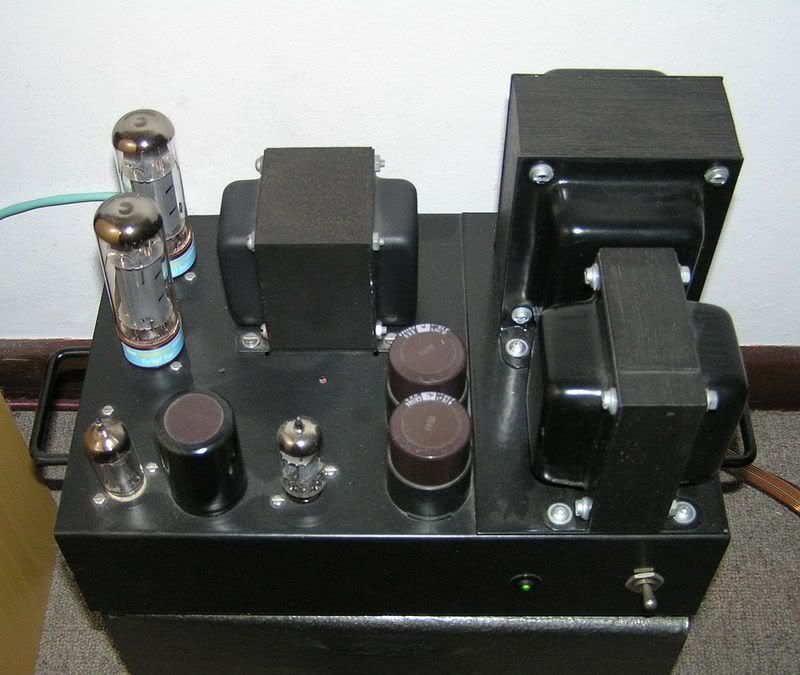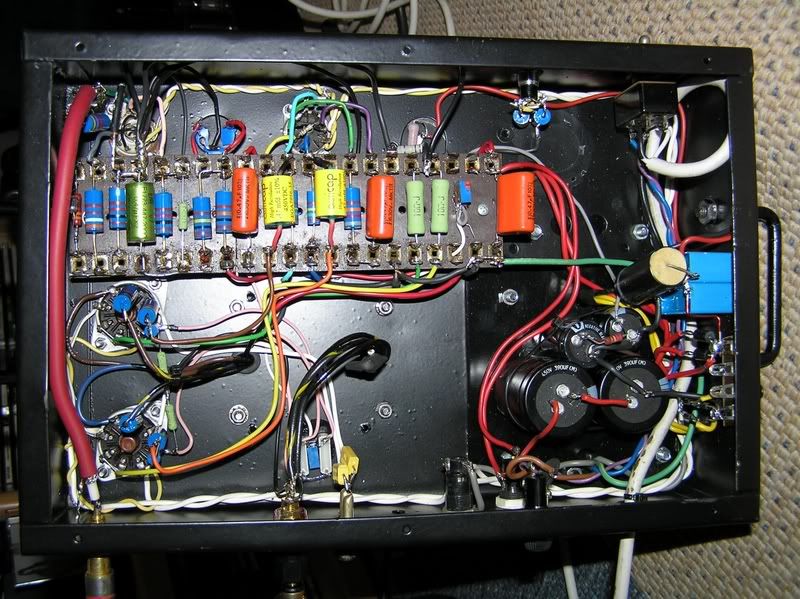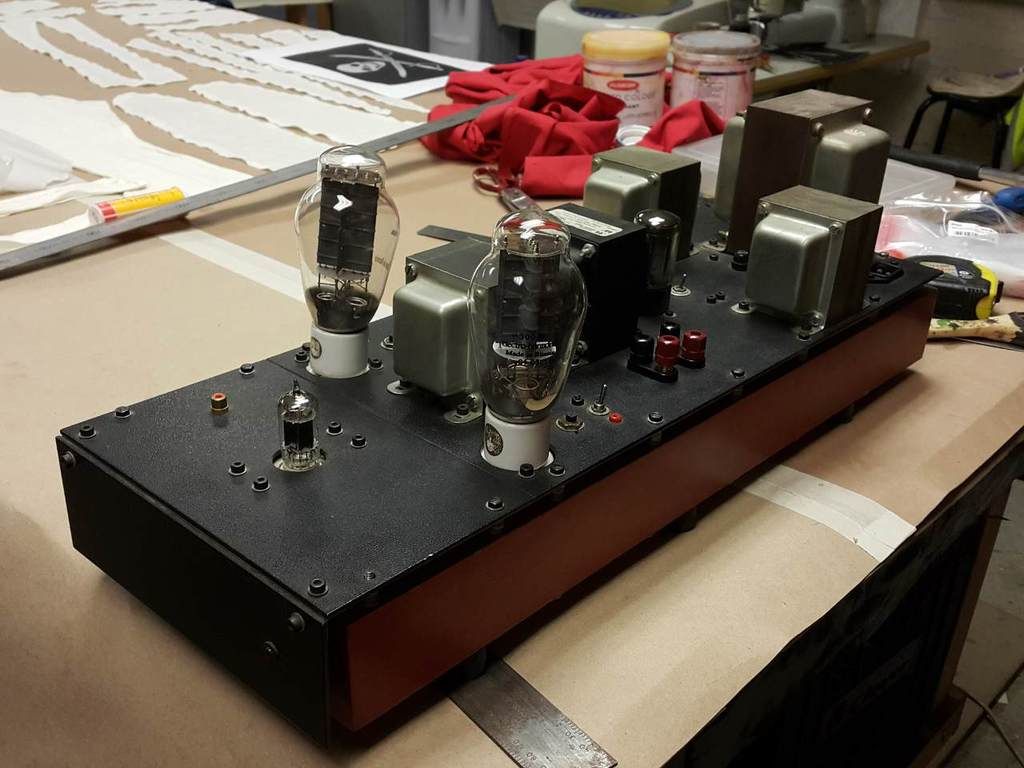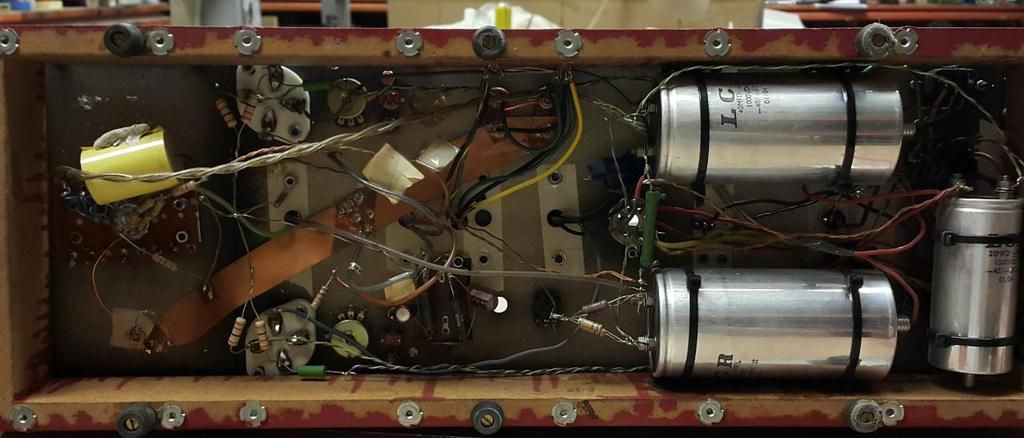Off the top of my head, no, but perhaps some of the very large ARC designs could handle such low load without blowing up. Also bear in mind that, it is not easy to find reasonably priced output transformers that has the required primary impedance AND high power handling capability, so be prepared to open your wallet.
I was wondering about the large ARC VT200 MK2 ( 8x KT88/channel ! ) , and what the damping factor on that is . But , yeah , 16x KT88 would set me back quite severely , and , as you say , OPT would be ridiculously expensive too .
I'm going to go a little OT now , just to give you an idea of my valve audio experience thus-far .
I have , in the past 5 years ( fast and furious audio foray ) bought and still own 4 2nd hand valve power amplifiers , all of them PP designs , when they came up at decent prices :
1. Dynaco ST35 circuit adapted for EL821 output by Karel Mars , valve maestro from South Africa . OPT's are from an old Pioneer valve amp , PT from Dynaco . A real SA audio community effort to build an affordable valve amp . This little amp ( 8-10 Wpc ) sounds fantastic driving highly inefficient B&W DM12's from Xonar STX soundcard in my PC . Images well , is not boomy , and is quite fast with complex and busy music .
Valve DIY build inspired by Mr Kent Kassler

2. Gunter Steinhart TVP502 E . 50 Wpc PL519 PP . Mr Steinhart was an Austrian born gentleman who emmigrated to South Africa for many years ( 20+ ? ) ago , he built seriously powerful valve amps using mostly TV tubes , long before they were this popular . This amp sounds very good , but I need to refurbish it , replace valves ( which are unfortunately soldered to PC board ) and caps . For those interested in a collection of Steinhart schematics look here : Steinhart Schematic
3. Mullard 5-20 modified to Byrith 4-30 spec by JDeV on this forum . Wow ! I'm so proud to own this amp , sounds so ridiculously good . In fact I was wondering if this is the circuit to double up on , substituting the El34's for either the 6P31S's ( and going down on the B+ and screen voltages ) or GU-50's with similar voltage to EL34 ?
http://www.diyaudio.com/forums/tubes-valves/12023-mullard-5-20-a-13.html#post707595


4. Jonothan Noble IS 300B PP - Got this at a good price ( worth it just for the iron ) , needs TLC and at least one new 300B ( so expensive ! ) . Sounds and images very well , but is noisy ( bad wiring methinks ) . Hard to find any info on this amp , I'm going to try and make schematic .


Some clarification maybe needed.
Pentode outputs (without N Fdbk) are high output impedance, so paralleling more will not help with final Rp alone. Adding a N Fdbk loop will lower the output impedance. However, the tubes/OT combo must be able to deliver the current commanded by the N Fdbk. So more tubes, or a bigger tube, CAN help meet the requirements.
I would take the lowest speaker impedance expected, at the highest power required (for bass boom say), and figure the peak speaker current required. Then work that backwards through the OT 1/turns ratio to get the peak current required from the tube(s). A higher primary Z OT will require less peak current from the tube(s), but may push you to a higher B+ voltage than desired, to meet the maximum (peak) power spec. (max. avg. power will be 1/2 that) I would stay below +450V B+ for reasonable economy of the power supply. (and also stay within the spec for the tube screen grid voltage for max knee current) A bigger tube or parallel tubes may solve any shortcoming on current. You have to play with the numbers for various tube and OT scenarios until a happy combo develops that meets the peak current requirement and the Watts output target.
Then you need to figure how much the native Rp of the tube(s) needs to be lowered to be less than the reflected Z of the speaker through the OT (determining speaker damping factor). That ratio will tell you how much N Fdbk loop gain is needed in the front end (the minimum). Could be global N Fdbk, or some form of "local" (non OT inclusive) N Fdbk.
6P36C looks to be rated 550 mA max peak for +170V on the screen grid.
6P45S/6KG6/EL509 1250 mA peak for +160V Vg2
36LW6 1400 mA peak for +180 Vg2
35LR6 1300 mA peak for +160 Vg2
21LG6 900 mA for +175 Vg2
26DQ5 870 mA peak for +175 Vg2
6HJ5 750 mA peak for +175 VG2
21HB5A 700 mA peak for +175 Vg2
6CB5A 540 mA peak for +175 Vg2
EL84 160 mA peak for +300 Vg2
EL34 350 mA peak for +350 Vg2
George (Tubelab) has found that around +150 Vg2 works well for low distortion with the TV sweep tubes (ie, for all of the above list, except EL84 and EL34). That would lower the peak current ratings above by Vg2'/Vg2 to the 1.5 power. (for example: 6P36C: 550mA x (150/170)^1.5 = 456 mA peak at +150 Vg2)
Have fun playing with the numbers! Something will work.
Hi smoking-amp ! Thanks for the comprehensive info , very good to see those peak currents listed . And the damping explanation - that helps a lot !
I have not seen any examples of local feedback ( not from OPT ) , would that be cathode or anode followers from drive tubes back to input tube control grid ?
Now I must learn to do the calculations .
What world do you live in? If lower impedance does no harm, then what is the point of having multiple output tubes?! Were the designers of those amplifiers smoking crack?🙄
Lower output impedance is not the point of paralleling tubes.
Designers do it to lower the primary turn ratio of the output transformer to get more Watts.
Designers of OTL do it to boost the feedback level higher than in a transistor amp.
Take a normal amp with plenty of gain and adjust the feedback resistor until it can drive your 2ohm load with authority. It will work.
As you posted your collection, maybe amp #2 , take the feedback resistor and put a lower value, listen and watch the woofer movement, if the tubes don't get red at max power you are fine!
Last edited:
Man, you have a great collection! Since all of them are more or less working, I don't think you should mess with them, except restoring them back to spec. If you are interested in building your own PPP amplifier, you should start with basic spec's: x Watts into y Ohm load, with z% THD. From that you can work your way backwards from the output stage to the input. But I think getting the OPT and the output tube selection sorted will be your first order of business, then of course, you need to set a budget for the build, since it has significant influence on the parts selection.I have , in the past 5 years ( fast and furious audio foray ) bought and still own 4 2nd hand valve power amplifiers , all of them PP designs...
TBH, I'm a Williamson man, so the Mullard and the Byrith designs really do not hold much interest for me. If I were you, I would build an improved Williamson design with a quartet of KT88/6550's, that ought to give you plenty of power. Good luck with your project!
p.s. what speakers are you planning to use for the amplifier?
Look here http://www.next-tube.com/articles/Veen2/Veen2EN.pdf to find some explanations.
Mona
Wow Mona ! Super tetrode connection , very interesting .
TBH, I'm a Williamson man, so the Mullard and the Byrith designs really do not hold much interest for me. If I were you, I would build an improved Williamson design with a quartet of KT88/6550's, that ought to give you plenty of power. Good luck with your project!
Hey jazbo8 - what do you think of Dick van der Merwe's " MonoBill Classic " ?
Perhaps this is the one to double up on - it measures extremely well - although it probably helps that one of Dick's friends winds his transformers , and I think they make the transformers over and over till they get it absolutely right . Also the transformers he is using are silver wound , the copper wound amorphous are €700/pair - I contacted the manufacturer - there are C-core and EI-core versions available for less .
Triodedick MonoBill Classic zelfbouw project - Audio Creative
p.s. what speakers are you planning to use for the amplifier?
I'm not looking at anything specific , but rather at an amp that has the ability to drive various speakers with ease , if I have to specify impedance , let's say .... 6ohm .
Last edited:
Looks fine except for the UL output section - which is against what Williamson stood for. 😉Hey jazbo8 - what do you think of Dick van der Merwe's " MonoBill Classic " ?
Fredeb,
Since you are a beginner it seems like much of the advice you have been given is good, though a bit staid. Probably for a first project the tried and true is the way to go. But here's something to think about.
You are interested in PPP, no? You can definitely use that idea in a synergistic way. The fewer stages the better for many reasons that I won't enumerate. Byrith suggested that the concertina as a PI doesn't have enough drive output for many output tubes. Well, that's correct up to a point but there are many advantages of a concertina stage over the long tailed pair. A concertina has a better upper harmonic spectrum than a differential pair - more 2nd and less 3rd harmonic. It also has a much lower output impedance on both upper and lower loads right up until grid current drive in the next stage. That means it goes farther driving the output before give up. And when it does start to give up driving the outputs the upper load gives up before the lower and that causes 2nd harmonic distortion. It isn't going to be as objectionable as odd harmonics until it's well into overdriving the output tubes.
So the problem is that the "total" rms output of the concertina stage is too limited. That's where the PPP comes in. You can eliminate an entire amplification stage if you use tubes like 6v6s or EL84s because of their relatively low drive voltage requirement. They are low power tubes but when you double them the amp will compare with the power similar topology of other tubes in PP. The advantage is that you get all the advantages of a very nice distortion signature of the concertina without the extra amplification stage and all the attendant headaches of the Williamson.
One more thing: Don't believe all the hooey that you need an exorbitant amount of total gain at the output because you want to put 20db of global negative feedback on it. That thinking will just KILL the life, spaciousness and inner detail of music. 3 to 6db of total global feedback is plenty.
Since you are a beginner it seems like much of the advice you have been given is good, though a bit staid. Probably for a first project the tried and true is the way to go. But here's something to think about.
You are interested in PPP, no? You can definitely use that idea in a synergistic way. The fewer stages the better for many reasons that I won't enumerate. Byrith suggested that the concertina as a PI doesn't have enough drive output for many output tubes. Well, that's correct up to a point but there are many advantages of a concertina stage over the long tailed pair. A concertina has a better upper harmonic spectrum than a differential pair - more 2nd and less 3rd harmonic. It also has a much lower output impedance on both upper and lower loads right up until grid current drive in the next stage. That means it goes farther driving the output before give up. And when it does start to give up driving the outputs the upper load gives up before the lower and that causes 2nd harmonic distortion. It isn't going to be as objectionable as odd harmonics until it's well into overdriving the output tubes.
So the problem is that the "total" rms output of the concertina stage is too limited. That's where the PPP comes in. You can eliminate an entire amplification stage if you use tubes like 6v6s or EL84s because of their relatively low drive voltage requirement. They are low power tubes but when you double them the amp will compare with the power similar topology of other tubes in PP. The advantage is that you get all the advantages of a very nice distortion signature of the concertina without the extra amplification stage and all the attendant headaches of the Williamson.
One more thing: Don't believe all the hooey that you need an exorbitant amount of total gain at the output because you want to put 20db of global negative feedback on it. That thinking will just KILL the life, spaciousness and inner detail of music. 3 to 6db of total global feedback is plenty.
Looks fine except for the UL output section - which is against what Williamson stood for. 😉
Is it a triode connection that you like ? It's been a couple of times now I've come across that preference . Is it a simpler , purer sound ? More than enough power for domestic use already ? Or maybe it's not triode connection at all ? 😀
Here is an interesting test report of some popular amplifiers: http://www.dtic.mil/dtic/tr/fulltext/u2/011593.pdf
Original Williamson is triode strapped pentode, ultra-linear was added as improvement later, the power output is doubled. Even so it should be useful as reference guideline.
Original Williamson is triode strapped pentode, ultra-linear was added as improvement later, the power output is doubled. Even so it should be useful as reference guideline.
Well I do like the triode output stage, especially if the output power is not the top priority, but I was actually referring to Williamson & Walker's well know feud with Keroes & Hafler about the "ultra-linear" topology - they were not the least impressed by it at all. You can download their article here.Is it a triode connection that you like ? It's been a couple of times now I've come across that preference . Is it a simpler , purer sound ? More than enough power for domestic use already ? Or maybe it's not triode connection at all ? 😀
Fredeb,
Since you are a beginner it seems like much of the advice you have been given is good, though a bit staid. Probably for a first project the tried and true is the way to go. But here's something to think about.
You are interested in PPP, no? You can definitely use that idea in a synergistic way. The fewer stages the better for many reasons that I won't enumerate. Byrith suggested that the concertina as a PI doesn't have enough drive output for many output tubes. Well, that's correct up to a point but there are many advantages of a concertina stage over the long tailed pair. A concertina has a better upper harmonic spectrum than a differential pair - more 2nd and less 3rd harmonic. It also has a much lower output impedance on both upper and lower loads right up until grid current drive in the next stage. That means it goes farther driving the output before give up. And when it does start to give up driving the outputs the upper load gives up before the lower and that causes 2nd harmonic distortion. It isn't going to be as objectionable as odd harmonics until it's well into overdriving the output tubes.
So the problem is that the "total" rms output of the concertina stage is too limited. That's where the PPP comes in. You can eliminate an entire amplification stage if you use tubes like 6v6s or EL84s because of their relatively low drive voltage requirement. They are low power tubes but when you double them the amp will compare with the power similar topology of other tubes in PP. The advantage is that you get all the advantages of a very nice distortion signature of the concertina without the extra amplification stage and all the attendant headaches of the Williamson.
One more thing: Don't believe all the hooey that you need an exorbitant amount of total gain at the output because you want to put 20db of global negative feedback on it. That thinking will just KILL the life, spaciousness and inner detail of music. 3 to 6db of total global feedback is plenty.
Hi exeric
I've been looking at the various PI configurations , and what you're saying seems to make a helluva lot of sense . Keep it as simple and clean as possible and double up on output tubes that require less drive .
Well I do like the triode output stage, especially if the output power is not the top priority, but I was actually referring to Williamson & Walker's well know feud with Keroes & Hafler about the "ultra-linear" topology - they were not the least impressed by it at all. You can download their article here.
Hi jazbo8 . The Keith Snook link doesn't work , but here is one that does : http://www.next-tube.com/articles/williamson/Williamson.pdf
I'll check that out now . Thank you Sir !
Wow ! Williamson indeed seems like an open-minded , intelligent man .
Williamson - " The contructor with limited facilities cannot be too strongly advised to keep to proven circuits , which are inherently trouble-free . In particular , he should keep to designs requiring the minimum number of coupled circuits in the OPT , since the possibility of pitfalls is greatest in this component and increases rapidly with the number of windings when all these must be closely coupled . "
Yes , I don't have an oscilloscope . 😱 . And I wish I knew how to wind transformers myself . It seems to me that many Russian/Eastern European/Eastern DIY'ers wind their own OPT's , necessity seems to be the mother of invention . And with the rapidly declining Rand , south Africa may be in the same boat . Make do .
BTW - can anyone please recommend a cheap USB PC oscilloscope that would work . I suppose signal generation can be done from my soundcard with software ?
Williamson - " The contructor with limited facilities cannot be too strongly advised to keep to proven circuits , which are inherently trouble-free . In particular , he should keep to designs requiring the minimum number of coupled circuits in the OPT , since the possibility of pitfalls is greatest in this component and increases rapidly with the number of windings when all these must be closely coupled . "
Yes , I don't have an oscilloscope . 😱 . And I wish I knew how to wind transformers myself . It seems to me that many Russian/Eastern European/Eastern DIY'ers wind their own OPT's , necessity seems to be the mother of invention . And with the rapidly declining Rand , south Africa may be in the same boat . Make do .
BTW - can anyone please recommend a cheap USB PC oscilloscope that would work . I suppose signal generation can be done from my soundcard with software ?
Last edited:
Wow ! Williamson indeed seems like an open-minded , intelligent man .
Williamson - " The contructor with limited facilities cannot be too strongly advised to keep to proven circuits , which are inherently trouble-free . In particular , he should keep to designs requiring the minimum number of coupled circuits in the OPT , since the possibility of pitfalls is greatest in this component and increases rapidly with the number of windings when all these must be closely coupled . "
I wish I knew how to wind transformers myself .
You'd better put a "Smiley," after that first statement about Williamson or readers will assume you were serious.
Hi exeric
I've been looking at the various PI configurations , and what you're saying seems to make a helluva lot of sense . Keep it as simple and clean as possible and double up on output tubes that require less drive .
I better mention that there is one significant fly in the ointment of what I said. The low power output tubes I mentioned generally only take about 300 volts on the plate. But to get maximum drive out of the concertina requires about 450 volts. One would probably want that just for flexibility in output tubes and later experimentation. The Williamson used output tubes that could use the same 450 volts applied to the concertina.
This means one has to have a separate voltage supply for the two stages. As you'll learn there are compromises in everything and one just has to weigh which ones you can live with. I've experimented with using a 385 volt rms (One Electron) center tapped power transformer in PSUD2 (A very good freely available downloadable tool that everyone should use) and made it to work. The 385vrms main supply ends up about 325vdc with dedicated full wave solid state rectifiers going into a choke input filter. You also need to feed the 385vrms into separate dedicated full wave ss rectifiers that feeds a capacitor input filter. That gives about 450 to 500vdc output. They will work more or less independently off of one ac voltage input.
These are things one has to know about beforehand because you can't just drop in a new topology and expect it to work like the Williamson. Only you can decide if you are ready to go there or if its too much at this point in your learning.
An important, and often overlooked concern: iron in the form of a well constructed transformer doesn't come cheap.Off the top of my head, no, but perhaps some of the very large ARC designs could handle such low load without blowing up. Also bear in mind that, it is not easy to find reasonably priced output transformer that has the required primary impedance AND high power handling capability, so be prepared to open your wallet.
Sent from my HP 10 G2 Tablet using Tapatalk
How about "open your wallet" in the above quote? The cost of good OPT's are already mentioned several times in this thread.
Hence my agreement, posted above.The costs of good OPT's are already mentioned several times in this thread.
Sent from my HP 10 G2 Tablet using Tapatalk
- Status
- Not open for further replies.
- Home
- Amplifiers
- Tubes / Valves
- Classic 4 valve PPP circuits